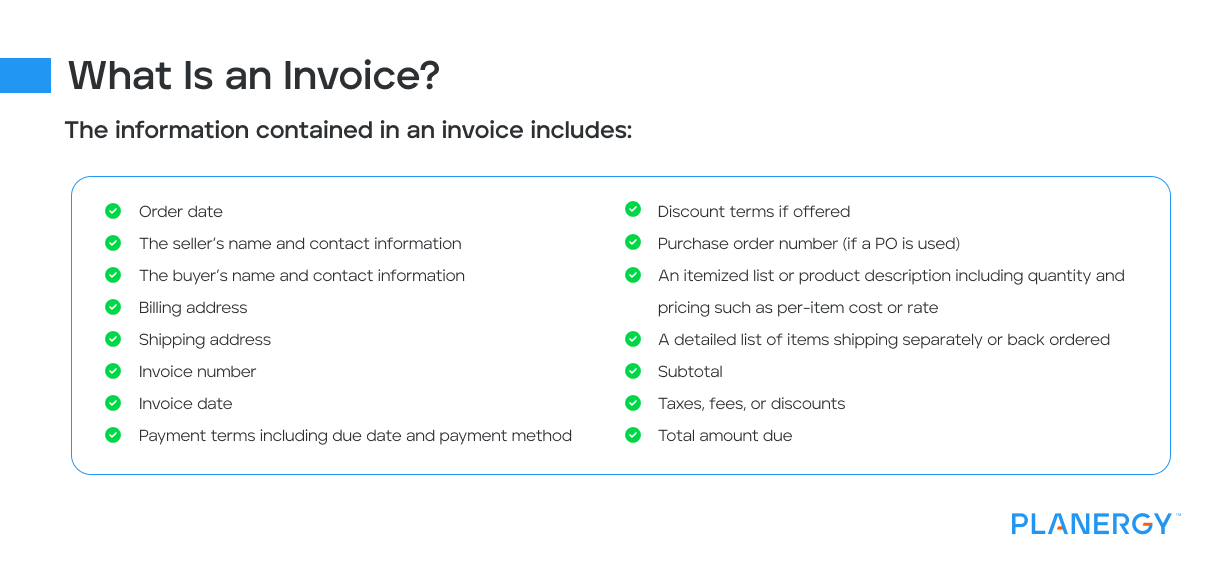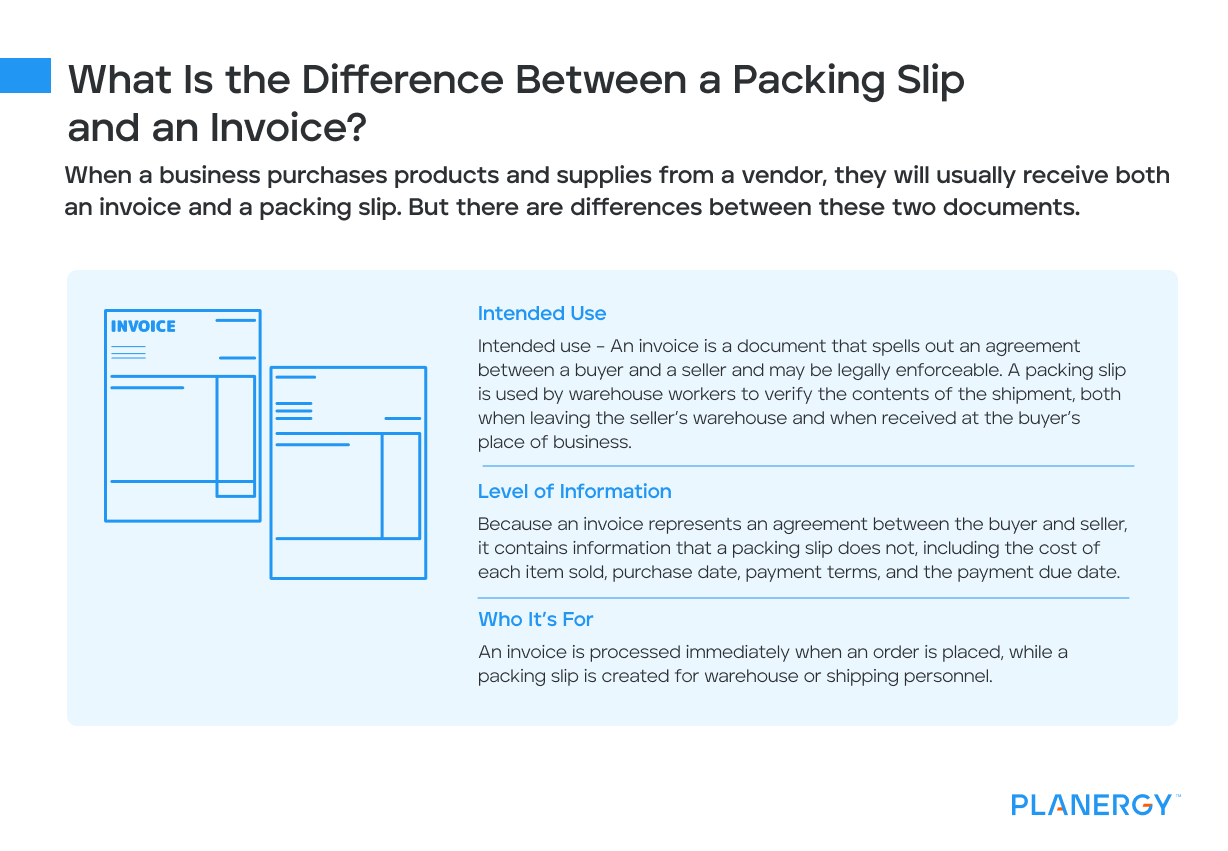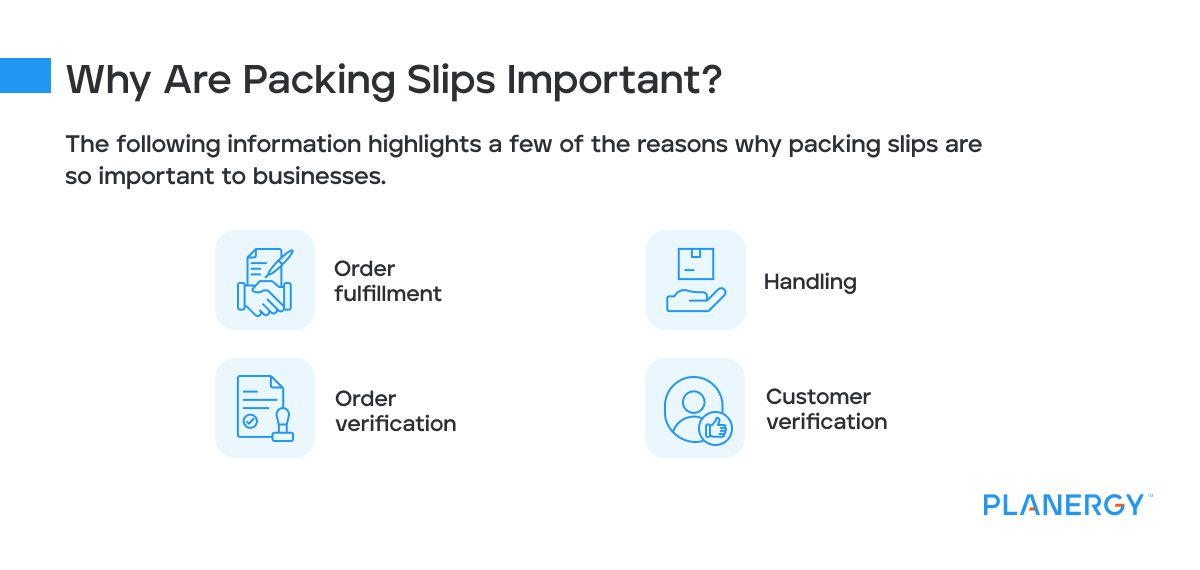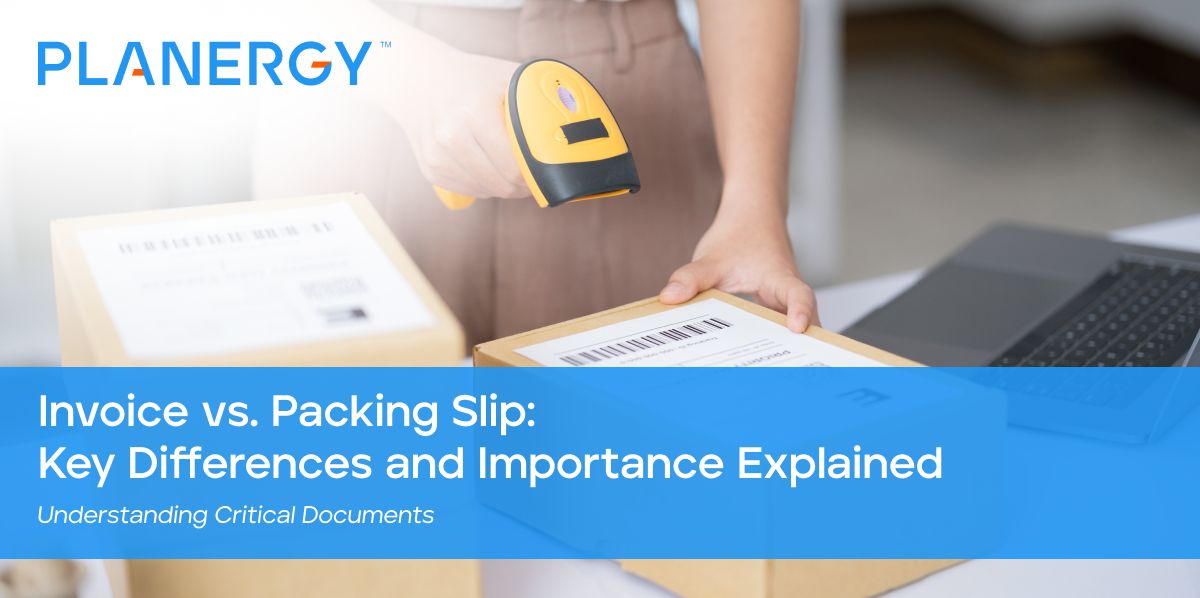If you regularly order or sell products, you’ve likely dealt with invoices and packing slips.
However, for business owners just becoming familiar with these documents, you may not be aware of the different purposes these two documents serve.
We’ll explain what an invoice and a packing slip are, what information they contain, and why they’re both important for your business.
What Is an Invoice?
An invoice is a financial document prepared by the seller that is sent to the buyer, once the order has been processed and shipped.
Though an invoice is not considered a legal document, it does serve as an official record of the transaction between the buyer and the seller.
Depending on the agreements or contracts in place between the buyer and the seller, an invoice tied directly to a contract may be legally enforceable.
An invoice provides a detailed description of the items being sold including the price and the quantity.
An invoice also includes the purchase date or invoice date, the date the products were shipped, any discounts or other cost reductions such as a previous credit applied, and the terms of payment.
The information contained in an invoice includes:

- Order date
- The seller’s name and contact information
- The buyer’s name and contact information
- Billing address
- Shipping address
- Invoice number
- Invoice date
- Payment terms including due date and payment method
- Discount terms if offered
- Purchase order number (if a PO is used)
- An itemized list or product description including quantity and pricing such as per-item cost or rate
- A detailed list of items shipping separately or back-ordered
- Subtotal
- Taxes, fees, or discounts
- Total amount due
What Is a Packing Slip?
A packing slip, also known as a shipping manifest, packing list, shipping document, or shipping list provides a detailed list of the items included in a shipment.
This list can be used by both the buyer and the seller to verify the contents of the shipment.
A packing slip is related to the invoice as it outlines important information relevant to product shipping.
However, a packing slip is concerned with what is shipping rather than what is ordered.
For instance, if you ordered 25 chairs from a furniture manufacturer, an invoice is used to bill you for the 25 chairs ordered.
If those chairs were later shipped in two shipments, the packing slip is used to convey the number of chairs included in each shipment, rather than the total number of chairs ordered.
Whenever a product is shipped, a packing slip should be included in the shipment when the order ships.
A packing slip is usually placed in a pouch that the shipper attaches to the box or carton that the item(s) are shipped in.
Packing slips are used exclusively for shipping physical goods.
For example, if ABC Roofing orders shingles, they’ll receive a packing slip for the order.
However, if they contract with a staffing agency to replace the receptionist temporarily, the order will not have a packing slip attached.
What Should a Packing Slip Include?
Much of the information included on an invoice is also included on a packing slip. This information includes:

- Order date
- Packing slip number
- PO number (if a PO is used)
- Shipping information
- Contact information
- An itemized list of products ordered including the quantity
- An itemized list of products shipped including the quantity
- SKU numbers and/or shipping label
- UPC or barcode
- Itemizing list of products shipped separately
- Weight information
In addition, unlike an invoice, which can be delivered electronically, a packing slip should always be printed and included with the shipment.
What Is the Difference Between a Packing Slip and an Invoice?
When a business purchases products and supplies from a vendor, they will usually receive both an invoice and a packing slip.
As we mentioned earlier, much of the information contained in both an invoice and a packing slip is the same.
But there are differences between these two documents.

Intended Use – An invoice is a document that spells out an agreement between a buyer and a seller and may be legally enforceable.
A packing slip is used by warehouse workers to verify the contents of the shipment, both when leaving the seller’s warehouse and when received at the buyer’s place of business.
Level of Information – Because an invoice represents an agreement between the buyer and seller, it contains information that a packing slip does not, including the cost of each item sold, purchase date, payment terms, and the payment due date.
Who It’s For – An invoice is processed immediately when an order is placed, while a packing slip is created for warehouse or shipping personnel.
How the Process Works
The invoice process begins when a purchase order is received or an order is placed.
Once the order is received by the seller, the process of filling the order begins.
Once this is complete, the order is prepared for shipment.
Before shipping, the buyer then creates an invoice and a packing slip.
The invoice is used as a way to formalize the order that was placed by the buyer, spelling out what was ordered, the quantity of items purchased, and how much each of those items is.
An invoice also indicates the date the order was processed, any discounts that the seller may want to offer the buyer, and the payment terms, including when payment for the invoice is due.
The invoice is then sent to the buyer, either via regular mail or electronically.
The second thing that happens after an order has been placed is that a packing list is prepared.
Used by the order fulfillment department, the packing slip provides a list of items that need to be included in the shipment.
Before shipping, the order is checked to ensure that the items in the packing list are included in the shipment.
If the products shipped are the same as what was ordered, the information on both the packing slip and the invoice will match.
However, if 100 items were ordered, but only 90 were shipped, it should indicate the discrepancy on the packing list.
The seller also needs to include other information on the packing slip, such as the total number of boxes or cartons shipped, the weight of the shipment, and the date it was shipped.
Once these two documents are received by the buyer, they take very different routes.
The invoice is routed to the proper individuals for review.
The packing slip is used by the receiving department to match the products received with what is included on the packing slip.
If they agree, the packing slip will be routed to AP, where it will be used during the three-way matching process, which matches a PO with an invoice and a packing slip.
By having all three of these documents match, AP can be sure that the invoice is accurate and continue processing it for payment.
If the information does not match, it will need to be investigated.
For example, if your business ordered 1,000 items, that information should be included on both the invoice and the packing slip, unless only 900 items were shipped.
If that is the case, the information on the invoice and the packing slip would differ.
Once the additional 100 out-of-stock items or missing items are received, you would have a packing slip for both shipments totaling 1,000 items, which can then be matched to the corresponding invoice.
One of the main causes of delays when paying an invoice is an exception like the one noted above.
These discrepancies can cause a delay in payment processing since you don’t want to pay an invoice if you haven’t received all of the products ordered.
Packing Slip Example
Below is a packing slip template that can be downloaded in Microsoft Word.
You can also create a packing slip using popular accounting software applications such as QuickBooks Online.
PACKING SLIP
Date:
| SHIPPING DETAILS | ||
|---|---|---|
| Your Company Name Street Address City, ST ZIP Code Phone Fax Number | SHIP TO: Name Company Name Street Address City, ST ZIP Code Phone Customer ID: ID | BILL TO: Name Company Name Street Address City, ST ZIP Code Phone Customer ID: ID |
ORDER DETAILS
| ORDER DATE | ORDER NUMBER | JOB |
|---|---|---|
ITEM DETAILS
| ITEM # | DESCRIPTION | QUANTITY |
|---|---|---|
Your Logo here
Please contact Customer Service at Phone with any questions or comments.
Your Company Slogan
THANK YOU FOR YOUR BUSINESS!
Why Are Packing Slips Important?
A packing slip is important to both buyers and sellers.
For sellers, not including a packing list with a shipment can make it difficult to prove that the items were shipped properly.
For buyers, tossing aside the packing slip can make it difficult to identify shipping issues such as a product shortage.
The following information highlights a few of the reasons why packing slips are so important to businesses.

Order Fulfillment
Once an order is received, a corresponding packing list should be created to help the order fulfillment department pack the order accurately.
Used as a pick list of sorts, having this list handy helps workers ensure that every order is packed and shipped accurately.
Order Verification
Once the order has been packed, the shipping department will use the packing slip to double-check that the contents of the box match the corresponding packing list.
Handling
The contents of the package play an important role in how a box is handled. If the contents being shipped are fragile or perishable, the box will need to be handled differently.
For example, a shipment of frozen pizzas would be handled very differently than a shipment of 2x4s.
Customer Verification
Once an order is received by the customer, the packing list can be used to verify that the contents of the box match what is on the packing list or any relevant delivery notes that are included on the packing slip.
Even more important, the packing list should also match both the purchase order used to place the order and the invoice received from the seller for the products shipped.
For example, packing slips can help businesses identify an anomaly between their order and what was received.
While an invoice may not reflect an order completed in two shipments, a packing slip would.
If you ignore a packing slip when received, you may incorrectly assume that the number of products received is the number of products ordered.
From Both Perspectives, Invoices, and Packing Slips Matter
Whether you routinely buy or sell products and services or both, how you manage your invoices and packing slips makes a difference.
As a buyer or seller, the best way to track orders and shipments properly is by using a completely integrated system that links the invoicing and packing slip process in real time.
With a completely integrated system you can easily manage your supply chain, streamline the order fulfillment process, improve the customer experience, while eliminating the need to manually print packing slips.




